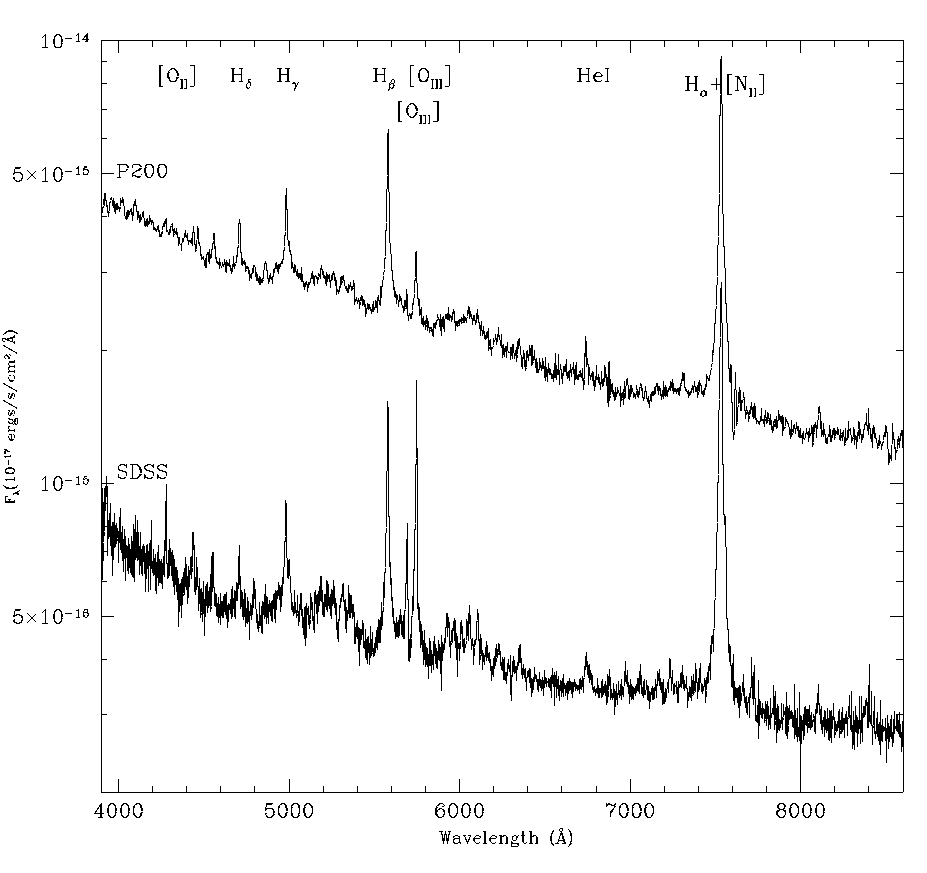We report the discovery and follow-up of an extremely luminous optical transient discovered by the Catalina Real-time Transient Survey( CRTS) on Feb 17.3UT.
| ID | Disc. Date | RA | Dec | Disc. Mag | Redshift |
|---|---|---|---|---|---|
| CSS100217:102913+404220 | 2010-02-17T07:16:31 | 10:29:12.56 | 40:42:20.0 | 16.2 | 0.148 |
Event CSS100217:102913+404220, is associated with object SDSS J102912.58+404219.7 which has gunn magnitudes u=18.2, g=17.9, r=17.7, i=17.4, z=17.5. as well as GALEX NUV = 19.3 and FUV = 19.8; 2MASS J=16.3, H=15.6, K=14.6; and NOMAD B=17.6, V=17.4, R=17.4. No radio source is seen in FIRST or VLSS data.
The SDSS spectrum
exhibits strong emission lines of width 450km/s at redshift z=0.15. Ho and Kim (2010)
find log[OIII/H_beta] = 0.14, log[NII/H_alpha] = -0.81, log[SII/Halpha] =-1.46 and log [OI/Halpha] =-1.42.
This clearly places the host galaxy within the locus of star-forming galaxies on the
BPT
( Kauffmann et al. 2003),
rather than AGN. However, Ho and Kim note that the galaxy spectrum also exhibits significant flux
from a broad (2000km/s) component suggesting of the presence of a AGN with the values best matching
a NLS1. The unusual placement on the BPT suggests the object exhibits a combination of star-formation
and AGN behaviour.
The metallicity of the object derived from the pre-outburst SDSS spectrum, using the R23-abundance relation, is 12 + log[O/H] = 9.1. This is consistent with the values expected for a galaxy with M_g = -21.3 (Tremonti et al. 2004). However, the presence of an AGN makes this value uncertain. The past CSS light curve exhibits a significant outburst beginning at the end of 2009. The rate of change is beyond that observed with Seyfert variability.
Follow-up g,r,i,z photometry was performed with the Palomar 60in telescope on Mar 02UT and Mar 11UT and gives g=16.2, r=15.8, i=16.0, z=15.9 with little change between observations. After subtracting the flux contribution from the galaxy and correcting for the foreground extinction, using the IRSA Galactic Reddening and Extinction Calculator value of Av=0.045, transformed to SDSS filters using Schlegel et al. 1998, we find the optical transient has the following absolute magnitudes Mg=-22.8, Mr=-23, Mi=-23.2, Mz=-23.3. We obtained SWIFT ToO time on April 6th which via pipeline reduction gave UVW1=16.1, UVM2=16.1, UVW2=16.3, U=15.8, B=16.5, V=16.2. After correcting for Galactic extinction using the relations of Roming et al. (2009) and redshift with standard WMAP cosmology we find M_UVW1= -23.1, M_UVM2= -23.2, M_UVW2=-23.0, M_U=-23.5, M_B=-22.7, M_V =-23.0 (these values have not been corrected for the original source luminosity as it is unknown in the UVW1,UVM2,UVW2 passbands). The object appears to be marginally detected in the SWIFT XRT x-ray image.
Spectra of the object were obtained with the IGO 2m+IFOSC on Feb 19th and April 5th, and with the Palomar 5m+DSBS of Mar 16UT. As shown below, these spectra resemble the initial SDSS host spectrum. However, the continuum and Balmer and HeI (5876) line have clearly increased in strength by a factor of five as well as become more symmetric. In contrast the [OII], [NII], and [OIII] lines remain at the same strength as in the SDSS spectrum. The presence of significant narrow Balmer emission is typical for the early spectra of type IIn supernova (see below) and the timescale of the luminosity increase is also consistent with such events. However, we find that line widths have not increased beyond the SDSS spectrum, suggesting no sign of expansion due to ejecta. However, after subtracting the SDSS spectrum from the P200 spectrum (below) we see what appears to be a very broad component which may well be the sign of this. If this event is truly due to a type IIn supernova, it is a magnitude more luminous than the brightest ever seen (SN 2008fz, SN 2008es). In this case, high resolution images could potentially reveal the presence of a supernova offset from the galaxy's nucleus.
An alternate possibility is that the event is due to tidal disruption flare. Indeed,
Ulmer (1997) note that
for very luminous tidal disruption flares can occur when there is a thick disk associated with tidal debris giving rise
to very blue continuum as well as emission lines. In particular, H_alpha emission from recombination lines due to
ionization of surrounding debris. Since the transient event is extremely bright, blue, and near the center of a luminous
galaxy it may well be a tidal disruption event. The increase in continuum and Balmer emission with little sign
of evolution in line widths, as well as a tentative X-ray detection, appears in agreement with this.
Further analysis is ongoing.
We request follow-up observations in all wavelengths (finding chart).
We thank the Swift PI Neil Gehrels for approving the requested ToO, and the Swift staff for planning and executing the observations.
We also thank M. Kim for the decomposition of the SDSS spectrum.








